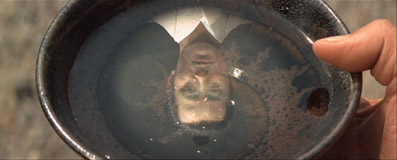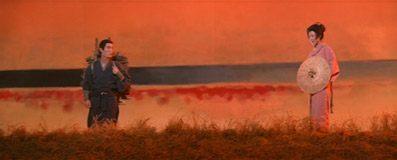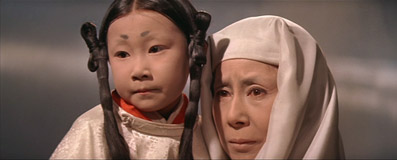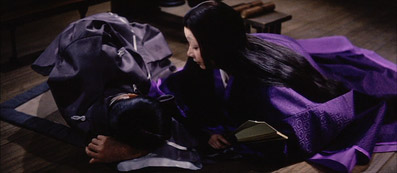|
It
is a little ironic that the author of one of Japan's most
widely known and respected collections of ghost stories
is not Japanese at all. Born in Greece of Irish-Greek parentage,
Lafcadio Hearn emigrated to America at the age of 19 and
worked for some years as a journalist in both Cincinnati
and New Orleans. Later he fell in love with Japan
and the Japanese way of life, and eventually moved there and raised a family. He continued to write on a variety of
subjects, some of his most prominent work being the adaptation
into prose of a number of supernaturally-based Japanese
folklore tales. These were published as collections such
as Shadowings (1900), Kottô: Being Japanese
Curios, with Sundry Cobwebs (1902) and Kwaidan:
Stories and Studies of Strange Things (1903). 61 years
after Hearn's death, Japanese director Kobayashi
Masaki set out to make a film of four stories adapted from the
above three volumes. The result was Kwaidan
(literally 'Ghost Story'), now rightly regarded as one of
the most successful cinematic realisations of the supernatural
yet to emerge from, well, anywhere.
In
the first story, The Black Hair, a poverty stricken
samurai divorces his loving and faithful wife and marries
the daughter of the Governor of a distant province,
in whose service he then works. But the marriage proves
to be an unhappy one, and ten years later, when the Governor's
official term of service is complete and the samurai is
freed of his obligations, he returns to Kyoto in search
of the woman he has been repeatedly dreaming of, and whom
he feels he has done a terrible injustice. But all is not
what it seems.

Woman
of the Snow finds old woodcutter Mosaku and his young
apprentice Minokichi caught in a snow storm on their way
home from the forest in which they collect their wares.
Cut off by a river, they take refuge in a broken-down hut,
but in the night Minokichi is awakened by the arrival of
a white-dressed woman, who kills Mosaku with
an icy breath. Feeling pity for Minokichi, she spares his
life, but on the condition that he never reveals what happened
that night to anyone, not even his most beloved. A year
later Minokichi meets a beautiful girl whom he takes for
his wife, and one night, many years later, he watches her
sew and is reminded of that fateful night...
Hoichi,
the Earless tells the story of blind storyteller Hoichi,
whose skilled biwa playing and emotive recital of the tale of the great sea battle
of Dan-no-ura has impressed a priest of the Amidaji
temple. The poverty-stricken Hoichi is offered a home there,
which he gladly accepts, being required only to occasionally
perform his musical and storytelling skills in lieu of rent.
Left alone in the temple one evening, he is visited by a
samurai in the service of a high-ranking lord – Hoichi's
recital of the battle of Dan-no-ura has become renowned and he
has been summoned to deliver the story to the court which
the samurai serves. Hoichi's skills impress the lord so much
that he is promised a large reward, but on the
condition that he return for the next six nights to repeat
his performance and that he tell no-one of his visits. Hoichi
is true to his word, but the temple priests become curious
about the nature of his night-time excursions, and one night
two of them are dispatched to follow him.
In
the final story, In a Cup of Tea, the attendant
of a lord resting at a tea house fills a large water cup
with tea to quench his thirst. As he raises the cup to his
mouth, however, he sees in it the face of a young samurai,
and yet there is no-one nearby to cast the reflection he
initially suspects it to be. Repeatedly the face appears,
and eventually the thirsty and frustrated attendant drinks
the tea regardless. But is it only tea that he has swallowed?

The
stories themselves are for the most part simple in
structure (reflecting their brief literary length) and
function, as do many works of horror fiction, as straightforward
morality tales. After many years of such stories from both
eastern and western film and fiction, few will nowadays
be startled at the individual outcomes. But like Hoichi's
tale of the battle of Dan-no-ura, the real pleasure of the
tales lies in their telling, and it is Masaki Kobayashi's
enviable skill as a cinematic storyteller that has
earned Kwaidan its unique place in cinema
history. And when I say unique I mean it – no other film
looks quite like it, none I have come across sound like
it, and its seamless blending of the theatrical and the
cinematic create a compelling sense of other-worldliness that at times seems to lift the tales out of their historical
context and into an alternate dimension.
Sometimes surreal in its evocation of waking nightmare,
the drama is frequently expressionistic in the externalisation of the
mental anguish of its characters. Visually
the film is rarely less than stunning, and I'm not talking
the chocolate box prettiness of Memoirs of a Geisha but a beauty that is as haunting as it is breathtaking.
Yoshio Miyajima's scope
photography and Shegemasu Toda's art direction are both
extraordinary throughout, but are never superficially
beautiful, always serving the story and atmosphere, sometimes
in semi-abstract or symbolic manner. This is most vividly
realised in the second story, The Woman in the Snow,
where red skies are sprinkled with large, watching eyes,
the light in a room suddenly shifts to evoke a memory, and
the sun is fragmented in the style a cubist painting.
The
film draws as much from Japanese theatre as it does from
film, the influence of Noh plays – in the sets,
the lighting, and the movement of characters – being repeatedly
evident. And yet the drifting camera and sometimes unexpected
angles recall the work of a number of Kobayashi's cinematic
predecessors, not least Mizoguchi Kenji, whose landmark
supernatural tale Ugetsu Monogatari has
clearly been inspirational here (not least in the sequence
in which spells are written all over Hoichi's body to protect
him from evil), as it would also prove to be for other directors
working in this genre.

Every
bit as striking as the imagery is the soundtrack, where
natural sounds are often completely removed and action
played out either in silence or accompanied by Takemitsu Tôru's
almost avant-garde score. The sometimes stark use of traditional
instrumentation blended with strangely altered sound effects
(the climax of The Black Hair, for example, is
peppered with the electronically treated noise of breaking
wood) proves genuinely unnerving, emphasising the theatrical
link and perfectly complimenting the film's visual stylistics.
Of
the stories themselves, Hoichi, the Earless is
usually singled out for the highest praise and it's not hard
to see why – it is the most substantial of the four (reflecting
the longer length of the original story when compared to
the others adapted here) and the most structurally complex.
The opening visualisation of Hoichi's battle tale at first
seeming like a splendidly realised but largely cosmetic
inclusion – only later to we realise just why we were shown
it in such detail. But this should in no way reflect negatively
on the other three stories which, although shorter and more
straightforward in their storytelling, are every bit as
compelling and rich in their detail. A little of this may be lost a non-Japanese audience, or at least one not
familiar with Japanese history and customs: the significance
of the title of the first story relates in part to the traditional
Japanese ghostly figure of a white-dressed woman with long
black hair (something seen more recently in horror works
such as Ringu); the white kimono worn by
the Woman in the Snow is how the bodies of the departed
are dressed for funeral services; following his encounter
with the Snow Woman, Minokichi meets and marries a woman
named Yuki, the Japanese word for snow; floating
fireballs are seen to represent the spirits of those who
have died; older marriage rites involved the bride blackening
her front teeth for the wedding, something that here could
be mistaken for a toothless smile. But the film never relies
on this small detail, and the underlying themes and morals
of tales themselves are universal and can be easily understood
and appreciated by any audience.
Although
the stories in no way connect, there are still thematic
and narrative links that bind them into a cogent whole.
The importance of agreements is central to the first three
stories and the breaking of them, for whatever reason,
is shown to have serious consequences. That it is twice
women who are wronged by men – whether it be a promise or
a declaration of marriage – and men who suffer the consequences
of their actions is a familiar aspect of Japanese ghost
stories and films. Most vividly, though, the film creates
the sense that the spirit world does not consist of a few
ghosts trapped in limbo, but is a very tangible and populous
place that co-exists with the land of the living and whose
inhabitants are more powerful than even the most ferocious
warrior. One thing is very clear – if you enter into an
agreement with a spiritual being, break your word at your
peril, and if you are going to protect yourself, then in
the name of the gods, do it properly.

In
the end, as I've already said, it's not so much the stories
themselves but the way they are told makes Kwaidan
such magnificent cinema. It combines operatic majesty with
the unhurried and almost abstract minimalism of Noh theatre
in a way that defies comparison. A beautiful, compelling
and chilling film, Kwaidan imbues the poetic
simplicity of Hearn's original tales with an almost Shakespearian
grandeur, and in a manner that will send shivers down your
spine.
Kwaidan was originally released in the West in a severely cut down
125 minute version, which was completely missing the Woman
in the Snow story. Its eventual restoration brought
the film up to 164 minutes, which for some time was considered
by many (myself included) to be the full version. Not so.
The original Japanese print ran for 183 minutes, 18 minutes
longer than the restored cut, suggesting that as well as
removing the second story, other cuts were also made to
get the running time closer to two hours for a US release.
This Masters of Cinema disc follows on from both Spanish
and Australian DVD releases in featuring that full, original
cut. There are no drastic changes to the four narratives,
the deleted footage consisting largely of extensions to
existing scenes, or brief additional sequences that expand
a little on story or character. A brief bit of nudity in
the second story was obviously lopped for a western market
that was still censorially uncertain about that sort of thing. Perhaps the
most surprising change is the slight extension of the first
story, more graphically emphasising the degree and speed
of change the affected character is experiencing.
This
is the second time Masters of Cinema have trodden where the
rightly revered Criterion have already walked – the first
was with Kaneto Shindo's Onibaba,
and there they actually beat the US specialists at their
own game. Putting aside for a moment the fact that this
is the full cut and thus has the edge over Criterion's release
on that score, on first glance the Criterion transfer seems
to have a definite edge – the colours are richer and the
contrast more striking. The screen captures below serve
to illustrate the differences between the two, although
are a little unfair on the Masters of Cinema disc – viewed
on a correctly balanced TV, the picture looks frankly terrific,
with colour, sharpness and contrast all looking just right.
|
Criterion (above) and the Masters of Cinema (below) |
|
|
|
Criterion (above) and the Masters of Cinema (below) |
|
The
shadow detail is considerably better on the MoC disc and
minor instances of damage on the Criterion transfer (the
start of the horseback archery contest is one) are not present
here. The print on the Criterion disc also appears to have
been slightly cropped from the original. Colours can vary
quite drastically on the two discs, and it's a tough call
to say which is correct, although the Criterion disc does
look more 'enhanced', even if it does make for some lovely
imagery. In the end it's a tough call between the two
for various reasons, but I'm going to have to go with the
MoC disc here.
It
should be noted that, unusually for a UK DVD release, the
transfer here is NTSC rather than the usual PAL. This both
preserves the original running time and speed and avoids
any potential NTSC to PAL transfer issues (the disc was
sourced from a Toho Japanese original). The vast majority
of modern TVs should have no problem at all handling an
NTSC signal. If your setup by some chance does not, then
this is something to take into consideration.
One
area in which the Masters of Cinema disc loses out to Criterion
is the soundtrack. While the sound on the Criterion disc
has been very effectively cleaned up, the MoC disc displays
a very audible crackle pretty much throughout. This is particularly
noticeable because of the film's pared-down use of sound,
including significant periods of silence.
Frankly
I'm surprised, given the film's length, that MoC were able
to squeeze anything else on this single DVD, but also included
are three trailers, a Black and White Japanese
Teaser (1:02), a Colour Japanese
Teaser (1:23), and a Japanese
Trailer (3:56). All are in surprisingly excellent
condition and anamorphically enhanced.
There
is also a Gallery of 10 production
stills and 8 posters, reproduced at a decent size.
Finally
there is, as ever, a quite superb accompanying Booklet,
typical of MoC but for my money their best yet. In the manner
of Criterion's Ugetsu disc, it contains
reprints of all four of Lafcadio Hearn's original stories
on which those in the film are based, a detailed biography
of director Masaki Kobayashi and an extensive interview
with him, a transcript from an interview conducted by Linda
Hoaglund and Peter Grilli for Charlotte Zwerin's 1994 documentary
Music for the Movies: Toru Takemitsu. The
whole thing is a splendid read and runs for a most impressive
72 pages.
If
you know the film then this is the DVD you have been waiting
for or perhaps even dreaming of (yep, that would be me).
Even if you have the Criterion disc then I'd still highly
recommend the Masters of Cinema release – this is the definitive
version of the film, has better shadow detail and a superb
accompanying booklet. The sound could do with a little cleaning
up, but otherwise this is an absolute must-buy. If you've
never seen the film, then this really is your lucky day.
|
